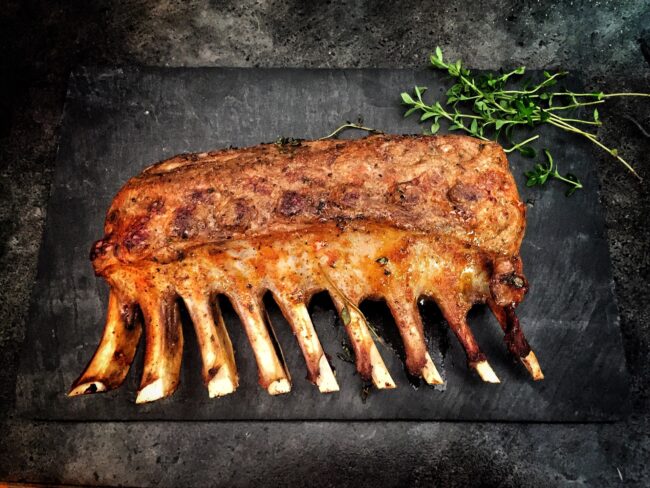Table of Contents
Contrary to the popular image that shows a dog drooling over a juicy bone, the latter is a hazardous snack for your furry friend.
Chicken bones are famous for injuring dogs. The thin bones often shatter when bitten and the sharp fragments can wound your dog’s mouth, throat, and digestive tract.
Gnawing on a cooked bone, including ribs, can lead to health risks such as cuts inside the mouth and throat, broken teeth, intestinal blockage, gastric issues, vomiting, diarrhea, constipation, colon blockage, and choking, or even death.
Dog Ate a Rib Bone – What To Do?
It can be hard to resist your dog’s puppy eyes pleading for a bone when you’re eating a juicy rack of ribs. Maybe you can resist, no problem – but your dog stole a rib from your plate or the trash. If you suspect that your pet has swallowed a rib, follow our guide below to help them as quickly as possible.
Check if Your Pup is Choking
The splinter-prone rib bones can get stuck inside your dog’s throat, causing them to choke. A dog might gag, use its front paw to desperately claw at its own face, or cry.
Look Out For Stomach Troubles
Those sharp pieces can get caught in your pup’s tummy and cause significant abdominal pain. If this is the case, your dog may look tired or refuse food. Moreover, your pup may vomit and experience digestive issues like constipation, diarrhea, bloody stool, troublesome bowel movement, or restlessness.
Uncharacteristic Behavior
Swallowing a bone might cause visible discomfort to your otherwise chirpy furry friend. Your dog may whine and cry, tremble, or pant, and either act lethargic or distressed.
What Happens If Your Dog Eats Rib Bones?
Eating rib bones can cause significant damage to your pup’s health. Firstly, a rib bone is very likely to break inside your dog’s mouth and cut the delicate tissues of the gums, tongue, lips, and throat. Furthermore, it can puncture or even cause partial or full blockage in the gastrointestinal tract.
Dog teeth aren’t designed to cut through bone and may lead to fractures, chips, cracks, or completely broken teeth. Lastly, due to its high-fat content, consuming a rib bone may lead to diarrhea and pancreatitis. In the worst case, it can even lead to death.
Can Your Dog’s Stomach Digest The Bone?
If the ingested bone reaches your dog’s stomach without causing damage, you can count your lucky stars. The acid inside your dog’s stomach can dissolve or digest the bone in most cases. Smaller bones would exit your dog’s system within 8 to 12 hours.
What Makes Rib Bones Troublesome?
Rib bones are typically cooked before being consumed. Cooking makes them more brittle and prone to shattering under pressure (like a dog’s bite). Splinters can make a dog choke or struggle to breathe. They can also block your pet’s gastric and digestive tracts. In short order, regardless of the type, all cooked bones pose a grave health risk to your dog.
What Can You Do When Your Dog Eats A Rib Bone?
Whether you should be making frantic calls to your vet mainly depends on whether the bone was cooked or uncooked. Raw bones shouldn’t be a cause to worry. Dogs are deliberately fed raw bones on the famous BARF or Biologically Appropriation Raw Food diet.
Their digestive system is well-suited to dissolve bones. However, cooked bones, especially rib bones, can be fatal for your dog’s health.
Primarily, you must take the bone away and open their mouth to check for more bone pieces. Try and remove them if you see any. Whether you can see clogged bones or not, it would help if you looked out for the above-listed symptoms, including choking and gagging. As soon you do, be sure to call your vet as soon as possible.
In the best case, your dog will digest the bone and pass it the next day. In extreme cases, the vet may perform surgery to remove the bone. At the end of the day, it’s crucial that you act quickly and contact a vet, whatever the symptoms.
Healthy Treats That Can Replace Bones
Now that you’re aware of the potential risks of giving rib bones to your dog, it doesn’t mean that they cannot have tasty snacks. There are plenty of healthy snacks for dogs available.
Bones are not all bad. They can help your dog during teething and improve bone and gum health. Plus, it can keep your dog engaged for quite some time.
You can treat your dog with raw ham bones. They are usually big and are safe enough to chew. You can easily procure high-quality ham bones from a local butcher. As an additional tip, be sure to give raw bone after feeding your dog a proper meal. This step will prevent them from trying to eat the bone.
Store-bought dog bones and rubber chew toys can be just as effective to curb a dog’s need to chew on something. You can even get a bone-like rubber toy for your pup.
A Quick Summary
Dogs love bones, but their guts do not. Feeding your dog cooked bones, whether it’s chicken, turkey, or beef, must be avoided.
If your dog eats rib bones, immediately call your veterinarian for advice and be on the lookout for symptoms such as choking, panting, restlessness, laziness, disturbed bowel movements, vomiting, and stomach ache.
Instead of risking your pet’s health, you can treat them to healthier alternatives like store-bought bones and specific raw bones. For a paw-some treat, be sure to consult your vet before trying out new foods.

